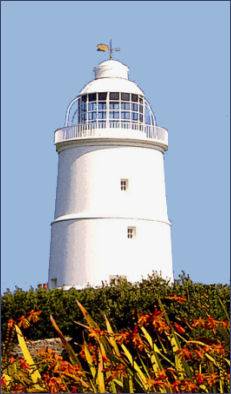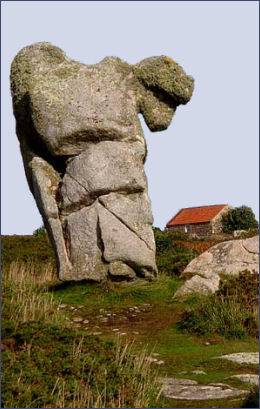St. Agnes
OS grid reference :- SV 881430

 The island of St. Agnes on the Isles of Scilly joins the smaller island of Gugh by a sandbar, known as the Gugh Bar, which is exposed only at low tide. The two islands together have the smallest population of the Scilly archipelago.
The island of St. Agnes on the Isles of Scilly joins the smaller island of Gugh by a sandbar, known as the Gugh Bar, which is exposed only at low tide. The two islands together have the smallest population of the Scilly archipelago.
St. Agnes, peaceful and unspoilt, is known in Cornish as Aganas meaning off-island. It is only a mile wide and is the southernmost populated island. St. Agnes boasts secluded sandy coves, with cushions of pink sea thrift flowering along the shore, a seventeenth century lighthouse and impressive views across the Western Rocks.
The whitewashed lighthouse (pictured right), the island's most famous landmark, which stands at its highest point, has now been converted into living accommodation and the tower no longer has its light.
Other landmarks on the island include a fantastically shaped standing stone known as the Nag's Head, (pictured below right) which is probably a natural formation. The stone stands at around 15 feet (4.5 metres) in height. There are many weird and wonderful rock formations on the island of St Agnes but the Nags Head is probably the most remarkable.
Periglis Beach makes for an excellent spot for a picnic, it offers stunning views across to the bird sanctuary that is Annet, the Western Rocks and out to Bishop Rock.
The so-called "Troytown Maze" a pebble maze is thought to be of medieval origin. The edges of the routes are made up of stones half buried in the ground. The maze is unicursal; that is, it does not contain dead-ends as in a puzzle maze but comprises a single path which leads inevitably to the centre.
Many of the sailors who had drowned in the great naval disaster off the Isles of Scilly in October 1707 were reputedly buried on the St Agnes playing field. The British naval fleet, under the command of Admiral of the Fleet Sir Cloudsley Shovell, was returning from Gibraltar to Portsmouth when they struck rocks to the west of Scilly. Four ships,Association, Firebrand, Romney and Eagle were lost and two thousand men lost their lives, including Sir Cloudsley Shovell himself who was initially buried on the beach at Porth Hellick.
 At Beady pool visitors often uncover glass and beads in the sand, remnants from a Dutch merchant shipwreck in the seventeenth century. Covean beach, a secluded bay, is accessible by a narrow track leading through trees.
At Beady pool visitors often uncover glass and beads in the sand, remnants from a Dutch merchant shipwreck in the seventeenth century. Covean beach, a secluded bay, is accessible by a narrow track leading through trees.
 St. Agnes is linked to the tiny island of Gugh, which is only truly an island at times of high tide, as it is joined to St. Agnes by a tombolo or sandbar, known as the Gugh Bar, which is exposed at low tide.
St. Agnes is linked to the tiny island of Gugh, which is only truly an island at times of high tide, as it is joined to St. Agnes by a tombolo or sandbar, known as the Gugh Bar, which is exposed at low tide.
The Old Man of Gugh, which lies at the base of Kittern Hill stands around 3 metres high and is thought to be associated with Bronze Age rituals, excavations carried out at at the monument failed to unearth any features or finds. Kittern Hill shows evidence of prehistoric dwellings and tombs including Obadiah's Barrow as well as the remains of ancient field walls.
Inland are quaint cottages and a patchwork of flower fields. Wingletang Down on the south of the island, is noted for its heather, dune grassland and rocky coast and is the only site in Britain where the fern, least adder's-tongue (Ophioglossum lusitanicum) grows. Other rare plants include the orchid, autumn lady's-tresses (Spiranthes spiralis) and early meadow-grass (Poa infirma).
St.Agnes overlooks the uninhabited island of Annet, a designated Area of Outstanding Natural Beauty, with a huge bird colony, the most famous of Annet's inhabitants is the puffin.
One of the islands' most iconic pubs, the Turks head, overlooks Porth Conger and is just a short walk from St Agnes Quay. Other popular eating establishments include Covean Cafe and Coastguard's Cafe.
| Bryher Island | Eastern Islands | Gugh Island | Nornour Island |
| St. Agnes | St. Helen's | St. Martins | St. Mary's |
| Tresco |